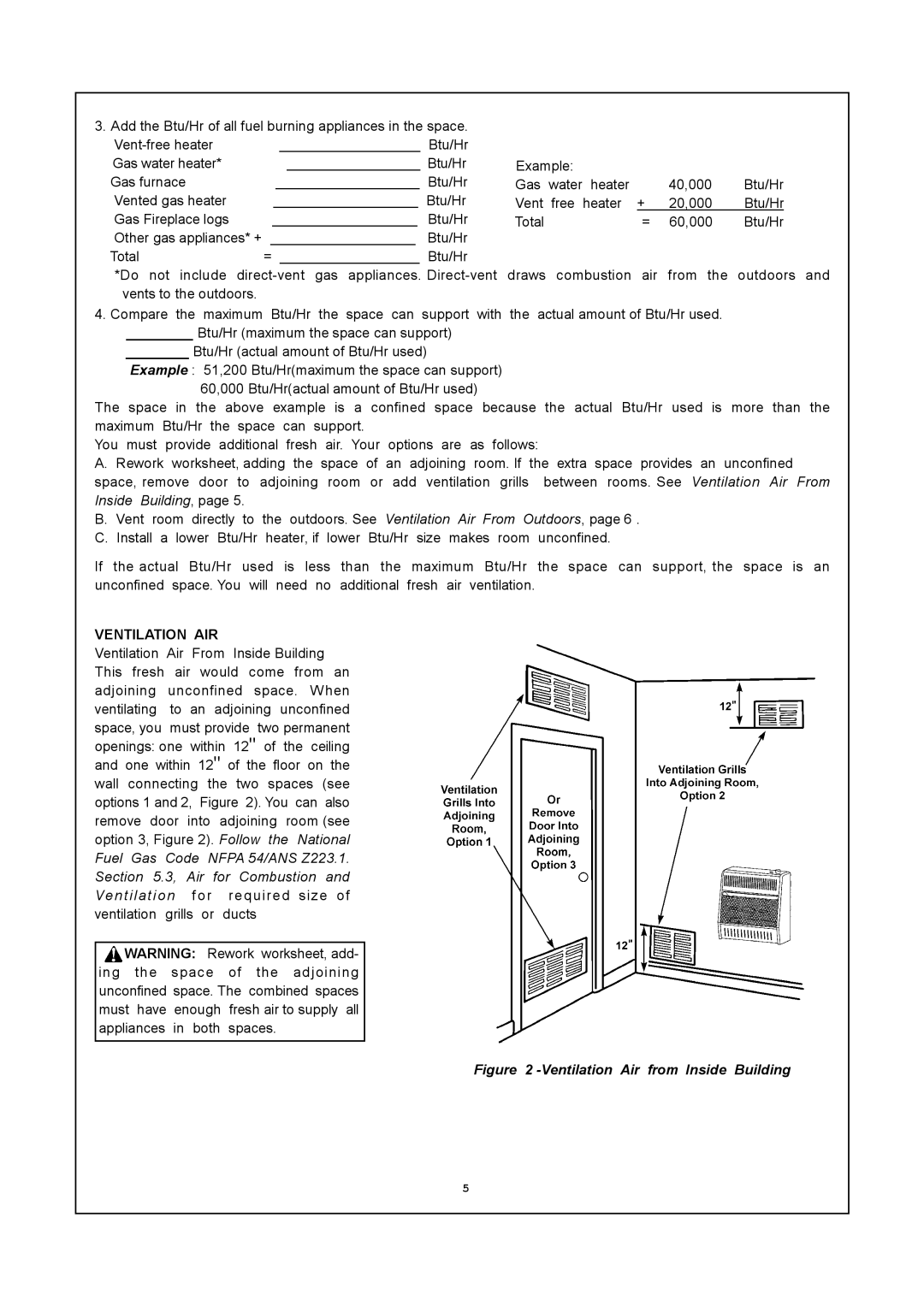
3. Add the Btu/Hr of all fuel burning appliances in the space. |
|
|
|
|
|
|
| |||||||||||
|
|
|
|
|
|
|
|
|
| Btu/Hr |
|
|
|
|
|
|
| |
Gas water heater* |
|
|
|
|
|
|
|
|
|
| Btu/Hr | Example: |
|
|
|
|
| |
Gas furnace |
|
|
|
|
|
|
|
|
|
| Btu/Hr | Gas | water | heater |
| 40,000 | Btu/Hr | |
Vented gas heater |
|
|
|
|
|
|
|
|
|
| Btu/Hr | Vent | free | heater | + | 20,000 | Btu/Hr | |
Gas Fireplace logs |
|
|
|
|
|
|
|
|
|
| Btu/Hr |
|
|
|
|
|
|
|
|
|
|
|
|
|
|
|
|
| Total |
|
| = | 60,000 | Btu/Hr | |||
Other gas appliances* + |
|
|
|
|
|
|
|
|
|
| Btu/Hr |
|
|
|
|
|
|
|
Total | = |
|
|
|
|
|
|
|
| Btu/Hr |
|
|
|
|
|
|
| |
*Do not include | gas appliances. | draws | combustion | air | from the | outdoors and | ||||||||||||
vents to the outdoors. |
|
|
|
|
|
|
|
|
|
|
|
|
|
|
|
|
|
|
4.Compare the maximum Btu/Hr the space can support with the actual amount of Btu/Hr used. Btu/Hr (maximum the space can support)
Btu/Hr (actual amount of Btu/Hr used)
Example : 51,200 Btu/Hr(maximum the space can support) 60,000 Btu/Hr(actual amount of Btu/Hr used)
The space in the above example is a confined space because the actual Btu/Hr used is more than the
maximum Btu/Hr the space can support. |
|
|
|
| |
You must provide additional fresh air. Your | options are | as | follows: | ||
A. Rework worksheet, adding the space of | an adjoining | room. If the extra space provides an unconfined | |||
space, remove door to | adjoining room or | add ventilation | grills | between rooms. See Ventilation Air From | |
Inside Building, page 5. |
|
|
|
|
|
B. Vent room directly to | the outdoors. See | Ventilation Air From Outdoors, page 6 . | |||
C. Install a lower Btu/Hr | heater, if lower Btu/Hr size makes | room | unconfined. | ||
If the actual Btu/Hr used is less than the maximum Btu/Hr the space can support, the space is an unconfined space. You will need no additional fresh air ventilation.
VENTILATION AIR
Ventilation Air From Inside Building This fresh air would come from an adjoining unconfined space. When ventilating to an adjoining unconfined space, you must provide two permanent openings: one within 12" of the ceiling and one within 12" of the floor on the wall connecting the two spaces (see options 1 and 2, Figure 2). You can also remove door into adjoining room (see option 3, Figure 2). Follow the National Fuel Gas Code NFPA 54/ANS Z223.1. Section 5.3, Air for Combustion and Ventilation for required size of ventilation grills or ducts
![]() WARNING: Rework worksheet, add- ing the space of the adjoining unconfined space. The combined spaces must have enough fresh air to supply all appliances in both spaces.
WARNING: Rework worksheet, add- ing the space of the adjoining unconfined space. The combined spaces must have enough fresh air to supply all appliances in both spaces.
Figure 2 -Ventilation Air from Inside Building
5
